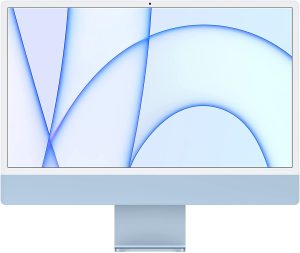
Much has been written about people embracing nostalgia for comfort during the COVID-19 pandemic. With the new 24-inch iMac's bright colors and simplistic design, Apple seems to be indulging in the pangs of nostalgia, too.
But the new iMac's nostalgia is only skin deep. Inside, it has arguably the most advanced CPU currently sold in consumer devices: the M1. This chip is equally at home in an iPad and a Mac, yet the M1 delivers performance that rivals or beats some of the best desktop chips available in some cases.Even though the M1 offers enough performance to attract power users, this new iMac isn't really for them. Rather, the 24-inch iMac is first and foremost about simplicity. It's a computer that promises users they won't have to think about how to configure or maintain a system. It's a computer that's more concerned about fitting into the room than it is about taking you somewhere else.
It's a computer that Apple could easily promote with the exact same ad that it ran back in 1998 for its inspiration, the iMac G3. "Presenting three easy steps to the Internet," said Jeff Goldblum, the commercial's narrator. "Step one: plug in. Step two: get connected. Step three... there is no step three." Say hello to iMac.
Table of Contents
Specs

Apple iMac (24-inch, 2021)
As with those Macs, the M1's CPU has four high-performance cores and four efficiency cores. The cheapest 24-inch iMac configuration ($1,299) has seven GPU cores, while the others have eight. Further, the cheapest model has a different cooling system, with just a single fan to the other configs' two.
At purchase, the computer can be configured with either 8GB or 16GB of unified memory and either 256GB, 512GB, or 1TB of solid-state storage. Ethernet is also an optional upgrade at an extra $30 for the base config (it's included automatically in the pricier configs), but that Ethernet port is in the power brick, not the Mac itself.
| Specs at a glance: 2021 24-inch iMac | |
|---|---|
| OS | macOS Big Sur 11.4 |
| CPU | Apple M1 |
| RAM | 16GB |
| GPU | Apple M1 |
| HDD | 512GB SSD |
| Networking | Wi-Fi 6; Bluetooth 5.0 |
| Ports | 2x Thunderbolt, 2x USB-C, 3.5mm headphone, gigabit Ethernet (on the power brick) |
| Warranty | 1 year, or 3 years with AppleCare+ |
| Price as reviewed | $1,899 |
Other ports besides Ethernet include a 3.5 mm headphone jack, two USB-3 (USB-C) ports, and two Thunderbolt/USB-C ports that support DisplayPort and USB 4 (up to 40Gb/s), as well as USB 3.1 Gen 2 (up to 10Gb/s). You'll need to buy some adapters for HDMI or anything else not listed here.
This is the first Mac in a long time with something like a MagSafe magnetic power adapter port, although Apple apparently doesn't call it that this time around. The port is a very different design than in previous Macs with MagSafe, but it's more or less what you'd expect, albeit a lot more resistant to popping out than the old MagSafe. Also returning from past iMacs is Touch ID, which until now has only been available with Apple's laptops. The iMac's keyboard comes with it, and Apple says it will work with other M1 Macs like the Mac mini if you pair the keyboard with those devices.
-
There are two Thunderbolt and two USB ports on the back.Samuel Axon
-
You'll find the headphone jack on the side.Samuel Axon
-
Here's the new power cable.Samuel Axon
-
And you'll find Ethernet on the power brick, provided you purchased a configuration that includes it.Samuel Axon
-
The camera has gone from 720p to 1080p, thankfully.Samuel Axon
-
You now get Touch ID in the keyboard that comes with the iMac.Samuel Axon
The display is quite glossy, albeit not as aggressively so as some previous iMacs, and Apple doesn't offer a matte or nanotexture configuration option.
Above the screen is a 1080p FaceTime HD camera. That's a big upgrade over the 720p camera in the 21.5-inch iMac but sort of on par with the most recent 27-inch iMac. I say "sort of," because this camera performs much better than the 1080p camera in the 27-inch iMac due to the M1's ISP.
The ISP enables computational photography and video capabilities like tone-mapping and noise reduction. In ideal shooting conditions, the difference compared to a non-M1 equivalent is modest, but we found that the ISP makes an enormous difference in suboptimal conditions, like low-light situations or when the user has a bright light behind them.
Three microphones will capture the audio on your video calls, and the new iMac has a six-speaker system that includes two pairs of woofers, each accompanied by a tweeter. Apply says these speakers do spatial audio via Dolby Atmos, though I maintain the advantages of Dolby Atmos are minimal in a stereo setup.
Wireless specs include Wi-Fi 6 and Bluetooth 5.0―pretty much what you expect from a computer these days.
Design
Never before have I seen a personal computing device that is so simultaneously futuristic and rooted in nostalgia.
Let's start with the futuristic part: the new iMac is just 11.5 mm (0.45 inches) thick. That means this 24-inch iMac has 50 percent reduced volume and a 30 percent smaller footprint than the 21.5-inch iMac it follows. It also has 50 percent smaller bezels above and to the sides of the screen.
It's so thin, in fact, that the headphone jack has to be on the side to fit the plug in, and the Ethernet port likewise has to live in the power brick. That last bit is a clever solution for the fact that many users have wanted Ethernet ports, but Apple's laptops (and now desktops) have gotten so thin they wouldn't fit. I wouldn't be surprised to see Apple offer the same option with future MacBooks.
-
The back of the 24-inch iMac.Samuel Axon
-
The front of the 24-inch iMac with Apple's M1 chip.Samuel Axon
-
That is one thin desktop computer.Samuel Axon
-
The hinge is easier to work with than what we got in the 21.5-inch iMac.Samuel Axon
As we learned from an X-ray and teardown over at iFixit, almost all of the silicon is in the device's chin, below the display. (There's also a small display board in the form of a strip along the inside of the top of the chassis, above the display.)
That at least explains the chin. Apple clearly decided to keep that chin in lieu of thickening the machine, either because the iMac's design team felt that thickening the chassis would take away from its blending-in-with-the-room vibe, because the chin is part of what makes a modern iMac recognizable as an iMac, because this approach netted what seemed like the best thermal management solution, or because of some combination of any of those things.In any case, the Apple logo we're used to seeing in that chin is not present; it's just blank space, which to me just accentuates how much, well, blank space there is. I don't dislike it, but it is a bit strange after the iMac has looked a certain way for so many years.
The thinness has some advantages besides aesthetics and space. The device is easier to transport between rooms, and the screen hinge is in a more manageable place because it doesn't have to support as much weight. Unfortunately, adjusting the iMac's height is still not possible.
reader comments
534